2000 BMW 328I key battery
[x] Cancel search: key batteryPage 20 of 189

20n
Indicator and warning lamps
Technology that monitors itself
Many of the systems of your BMW
monitor themselves automatically, both
during engine starts and while you are
driving. Indicator and warning lamps
that are identified by "
l
" are tested for
proper functioning whenever the igni-
tion key is turned. They each light up
once for different periods of time.
If a fault should occur in one of these
systems, the corresponding lamp does
not go out after the engine is started, or
it lights up while the vehicle is moving.
You will see how to react to this below.
Red: Stop immediately
Battery charge
l
The battery is no longer being
charged. There is a malfunction
of the alternator ribbed V-belt or in the
charging circuit of the alternator. Please
contact the nearest BMW center.
If the ribbed V-belt is defective, do
not continue driving. If you do so,
the engine could be damaged due to
overheating. If the ribbed V-belt is de-
fective, increased steering effort is also
required.<
Engine oil pressure l
Stop the vehicle and switch off
the engine immediately. Check
the engine oil and top up as required. If
the oil level is correct, please contact
the nearest BMW center.
Do not continue driving. If you do
so, the engine could be damaged
because of inadequate lubrication.<
Tire Pressure Control (RDC)
* l
In addition, an acoustic signal is
sounded: A tire failure has oc-
curred. Reduce vehicle speed immedi-
ately and stop the vehicle. Avoid hard
brake applications. Do not oversteer.
For additional information: Refer to
page 80.
Brake hydraulic system l
If the lamp comes on when the
parking brake is not engaged:
Check the brake fluid level. Before driv-
ing further, be sure to read the notes on
pages 109 and 129.
Brake warning lamp for Cana-
dian models.
Page 32 of 189
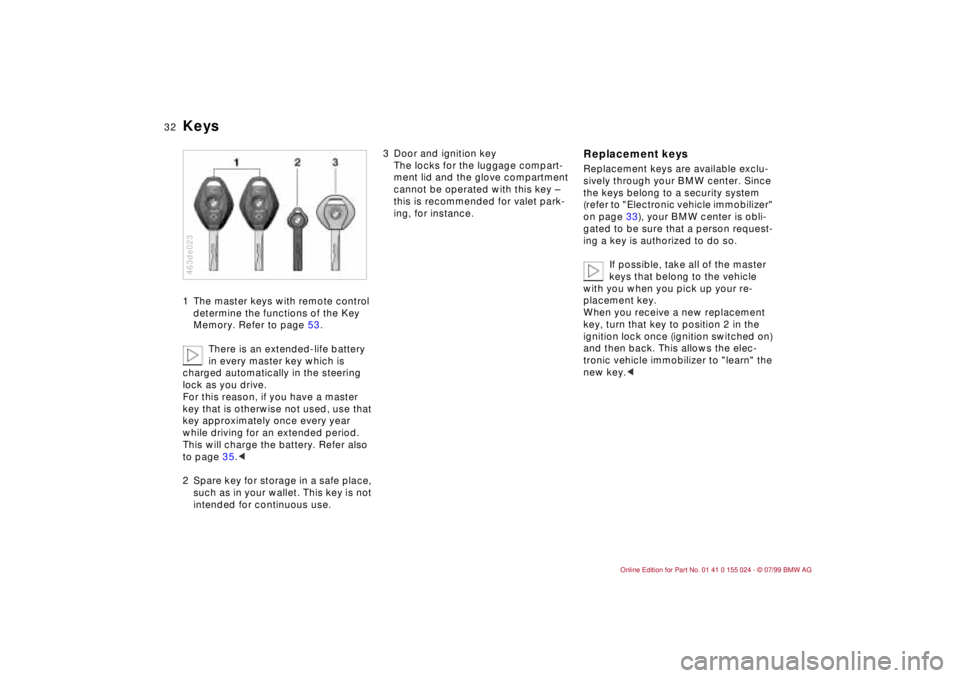
32n
Keys1 The master keys with remote control
determine the functions of the Key
Memory. Refer to page 53.
There is an extended-life battery
in every master key which is
charged automatically in the steering
lock as you drive.
For this reason, if you have a master
key that is otherwise not used, use that
key approximately once every year
while driving for an extended period.
This will charge the battery. Refer also
to page 35.<
2 Spare key for storage in a safe place,
such as in your wallet. This key is not
intended for continuous use. 463de023
3 Door and ignition key
The locks for the luggage compart-
ment lid and the glove compartment
cannot be operated with this key Ð
this is recommended for valet park-
ing, for instance.
Replacement keysReplacement keys are available exclu-
sively through your BMW center. Since
the keys belong to a security system
(refer to "Electronic vehicle immobilizer"
on page 33), your BMW center is obli-
gated to be sure that a person request-
ing a key is authorized to do so.
If possible, take all of the master
keys that belong to the vehicle
with you when you pick up your re-
placement key.
When you receive a new replacement
key, turn that key to position 2 in the
ignition lock once (ignition switched on)
and then back. This allows the elec-
tronic vehicle immobilizer to "learn" the
new key.<
Page 35 of 189
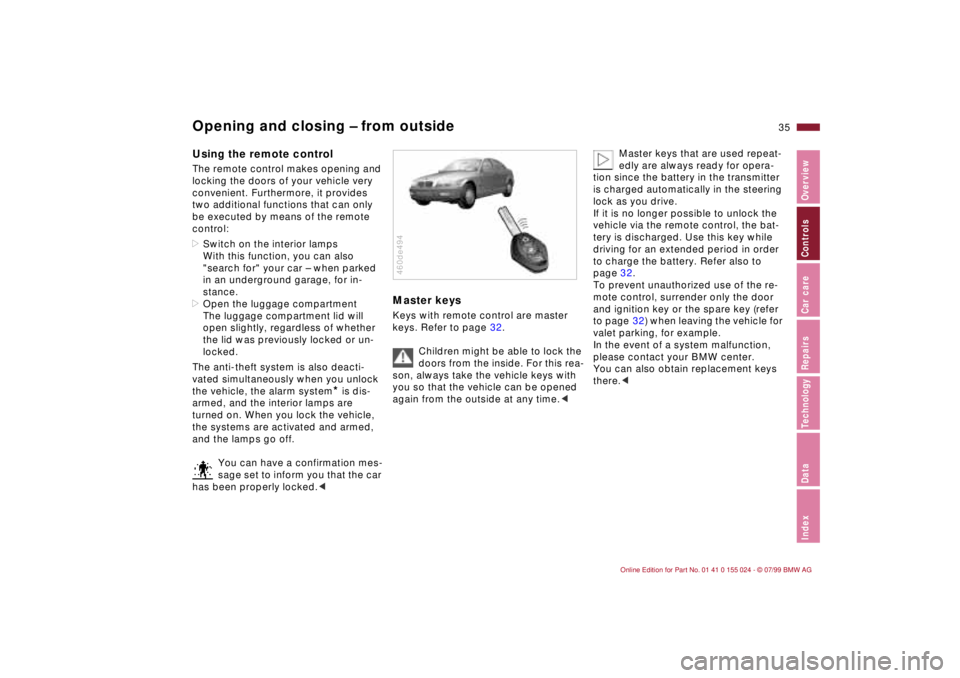
35n
IndexDataTechnologyRepairsCar careControlsOverview
Opening and closing Ð from outsideUsing the remote control The remote control makes opening and
locking the doors of your vehicle very
convenient. Furthermore, it provides
two additional functions that can only
be executed by means of the remote
control:
>Switch on the interior lamps
With this function, you can also
"search for" your car Ð when parked
in an underground garage, for in-
stance.
>Open the luggage compartment
The luggage compartment lid will
open slightly, regardless of whether
the lid was previously locked or un-
locked.
The anti-theft system is also deacti-
vated simultaneously when you unlock
the vehicle, the alarm system
* is dis-
armed, and the interior lamps are
turned on. When you lock the vehicle,
the systems are activated and armed,
and the lamps go off.
You can have a confirmation mes-
sage set to inform you that the car
has been properly locked.<
Master keysKeys with remote control are master
keys. Refer to page 32.
Children might be able to lock the
doors from the inside. For this rea-
son, always take the vehicle keys with
you so that the vehicle can be opened
again from the outside at any time.<460de494
Master keys that are used repeat-
edly are always ready for opera-
tion since the battery in the transmitter
is charged automatically in the steering
lock as you drive.
If it is no longer possible to unlock the
vehicle via the remote control, the bat-
tery is discharged. Use this key while
driving for an extended period in order
to charge the battery. Refer also to
page 32.
To prevent unauthorized use of the re-
mote control, surrender only the door
and ignition key or the spare key (refer
to page 32) when leaving the vehicle for
valet parking, for example.
In the event of a system malfunction,
please contact your BMW center.
You can also obtain replacement keys
there.<
Page 42 of 189
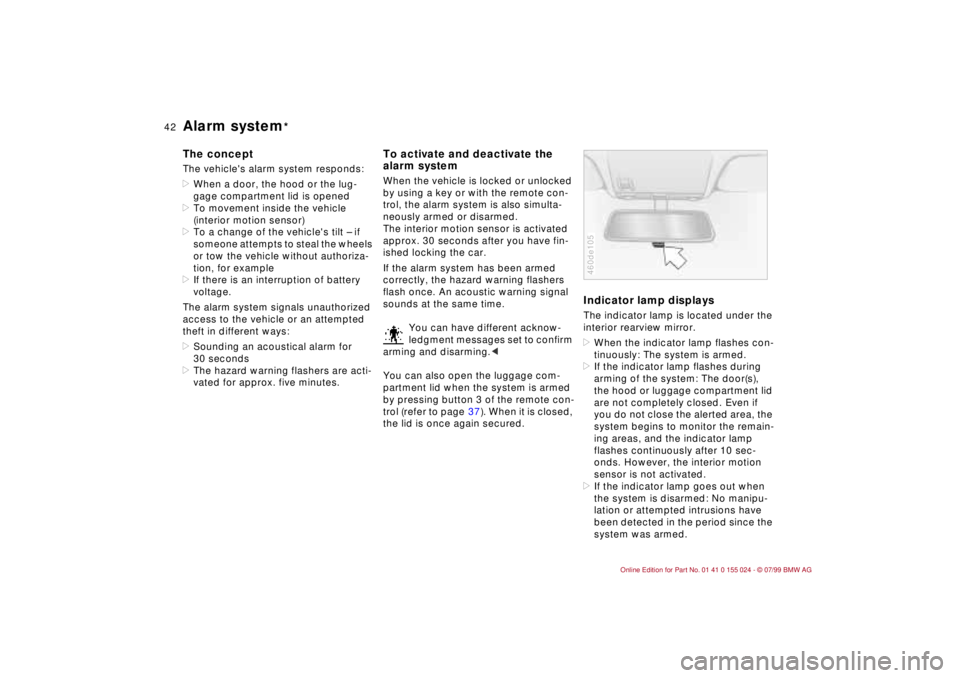
42n
Alarm system
*
The conceptThe vehicle's alarm system responds:
>When a door, the hood or the lug-
gage compartment lid is opened
>To movement inside the vehicle
(interior motion sensor)
>To a change of the vehicle's tilt Ð if
someone attempts to steal the wheels
or tow the vehicle without authoriza-
tion, for example
>If there is an interruption of battery
voltage.
The alarm system signals unauthorized
access to the vehicle or an attempted
theft in different ways:
>Sounding an acoustical alarm for
30 seconds
>The hazard warning flashers are acti-
vated for approx. five minutes.
To activate and deactivate the
alarm systemWhen the vehicle is locked or unlocked
by using a key or with the remote con-
trol, the alarm system is also simulta-
neously armed or disarmed.
The interior motion sensor is activated
approx. 30 seconds after you have fin-
ished locking the car.
If the alarm system has been armed
correctly, the hazard warning flashers
flash once. An acoustic warning signal
sounds at the same time.
You can have different acknow-
ledgment messages set to confirm
arming and disarming.<
You can also open the luggage com-
partment lid when the system is armed
by pressing button 3 of the remote con-
trol (refer to page 37). When it is closed,
the lid is once again secured.
Indicator lamp displaysThe indicator lamp is located under the
interior rearview mirror.
>When the indicator lamp flashes con-
tinuously: The system is armed.
>If the indicator lamp flashes during
arming of the system: The door(s),
the hood or luggage compartment lid
are not completely closed. Even if
you do not close the alerted area, the
system begins to monitor the remain-
ing areas, and the indicator lamp
flashes continuously after 10 sec-
onds. However, the interior motion
sensor is not activated.
>If the indicator lamp goes out when
the system is disarmed: No manipu-
lation or attempted intrusions have
been detected in the period since the
system was armed.460de105
Page 84 of 189
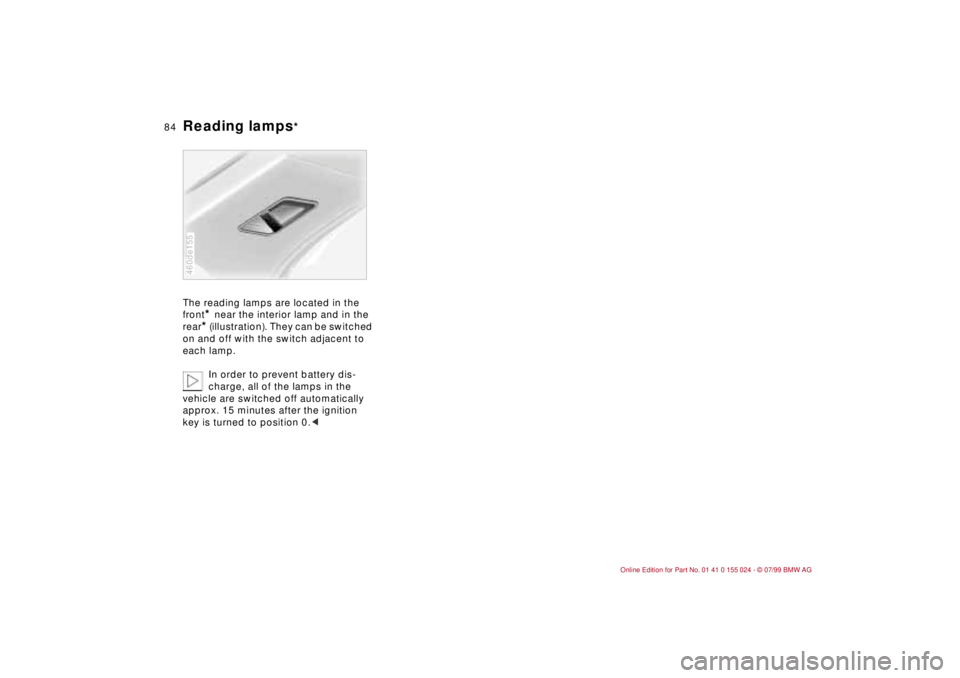
84n
Reading lamps
*
The reading lamps are located in the
front
* near the interior lamp and in the
rear
* (illustration). They can be switched
on and off with the switch adjacent to
each lamp.
In order to prevent battery dis-
charge, all of the lamps in the
vehicle are switched off automatically
approx. 15 minutes after the ignition
key is turned to position 0.<
460de155
Page 153 of 189
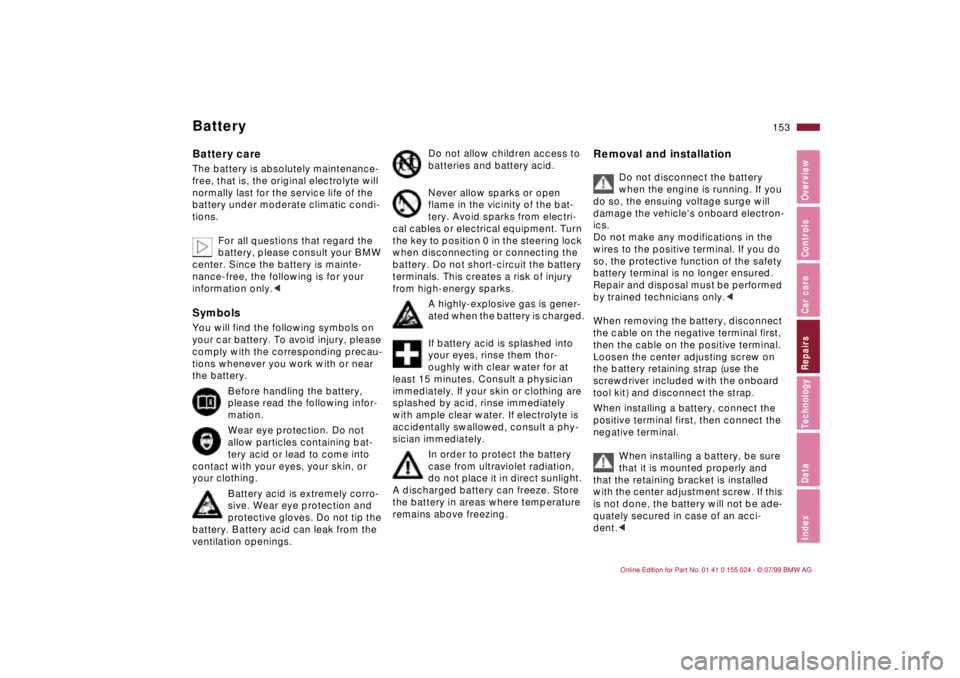
153n
IndexDataTechnologyRepairsCar careControlsOverview
BatteryBattery careThe battery is absolutely maintenance-
free, that is, the original electrolyte will
normally last for the service life of the
battery under moderate climatic condi-
tions.
For all questions that regard the
battery, please consult your BMW
center. Since the battery is mainte-
nance-free, the following is for your
information only.
comply with the corresponding precau-
tions whenever you work with or near
the battery.
Before handling the battery,
please read the following infor-
mation.
Wear eye protection. Do not
allow particles containing bat-
tery acid or lead to come into
contact with your eyes, your skin, or
your clothing.
Battery acid is extremely corro-
sive. Wear eye protection and
protective gloves. Do not tip the
battery. Battery acid can leak from the
ventilation openings.
Do not allow children access to
batteries and battery acid.
Never allow sparks or open
flame in the vicinity of the bat-
tery. Avoid sparks from electri-
cal cables or electrical equipment. Turn
the key to position 0 in the steering lock
when disconnecting or connecting the
battery. Do not short-circuit the battery
terminals. This creates a risk of injury
from high-energy sparks.
A highly-explosive gas is gener-
ated when the battery is charged.
If battery acid is splashed into
your eyes, rinse them thor-
oughly with clear water for at
least 15 minutes. Consult a physician
immediately. If your skin or clothing are
splashed by acid, rinse immediately
with ample clear water. If electrolyte is
accidentally swallowed, consult a phy-
sician immediately.
In order to protect the battery
case from ultraviolet radiation,
do not place it in direct sunlight.
A discharged battery can freeze. Store
the battery in areas where temperature
remains above freezing.
Removal and installation
Do not disconnect the battery
when the engine is running. If you
do so, the ensuing voltage surge will
damage the vehicle's onboard electron-
ics.
Do not make any modifications in the
wires to the positive terminal. If you do
so, the protective function of the safety
battery terminal is no longer ensured.
Repair and disposal must be performed
by trained technicians only.<
When removing the battery, disconnect
the cable on the negative terminal first,
then the cable on the positive terminal.
Loosen the center adjusting screw on
the battery retaining strap (use the
screwdriver included with the onboard
tool kit) and disconnect the strap.
When installing a battery, connect the
positive terminal first, then connect the
negative terminal.
When installing a battery, be sure
that it is mounted properly and
that the retaining bracket is installed
with the center adjustment screw. If this
is not done, the battery will not be ade-
quately secured in case of an acci-
dent.<
Page 186 of 189
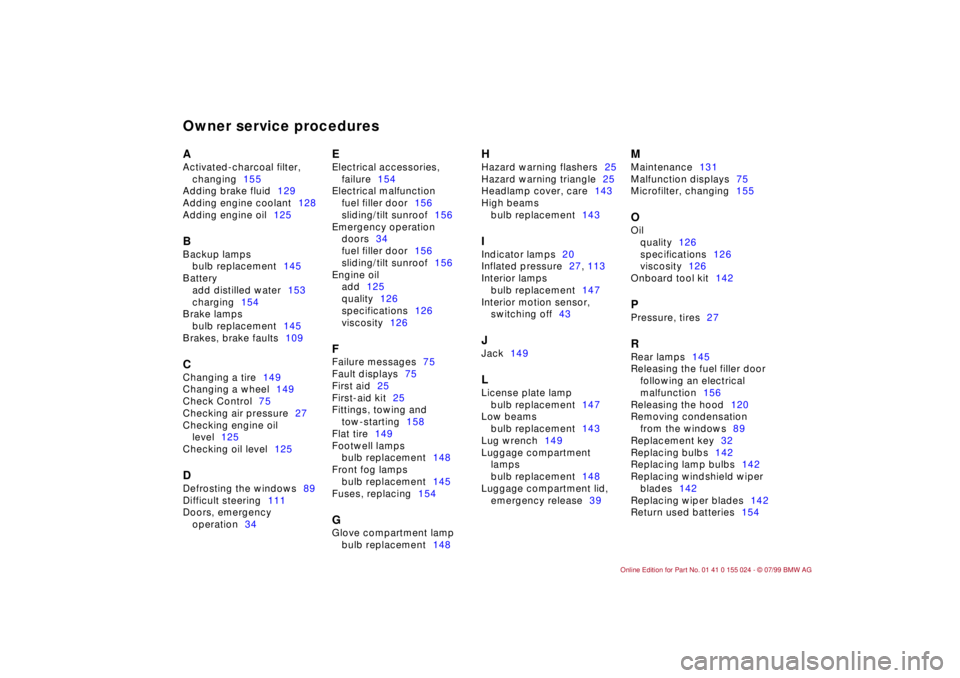
Owner service proceduresAActivated-charcoal filter,
changing155
Adding brake fluid129
Adding engine coolant128
Adding engine oil125BBackup lamps
bulb replacement145
Battery
add distilled water153
charging154
Brake lamps
bulb replacement145
Brakes, brake faults109CChanging a tire149
Changing a wheel149
Check Control75
Checking air pressure27
Checking engine oil
level125
Checking oil level125DDefrosting the windows89
Difficult steering111
Doors, emergency
operation34
EElectrical accessories,
failure154
Electrical malfunction
fuel filler door156
sliding/tilt sunroof156
Emergency operation
doors34
fuel filler door156
sliding/tilt sunroof156
Engine oil
add125
quality126
specifications126
viscosity126FFailure messages75
Fault displays75
First aid25
First-aid kit25
Fittings, towing and
tow-starting158
Flat tire149
Footwell lamps
bulb replacement148
Front fog lamps
bulb replacement145
Fuses, replacing154GGlove compartment lamp
bulb replacement148
HHazard warning flashers25
Hazard warning triangle25
Headlamp cover, care143
High beams
bulb replacement143IIndicator lamps20
Inflated pressure27, 113
Interior lamps
bulb replacement147
Interior motion sensor,
switching off43JJack149LLicense plate lamp
bulb replacement147
Low beams
bulb replacement143
Lug wrench149
Luggage compartment
lamps
bulb replacement148
Luggage compartment lid,
emergency release39
MMaintenance131
Malfunction displays75
Microfilter, changing155OOil
quality126
specifications126
viscosity126
Onboard tool kit142PPressure, tires27RRear lamps145
Releasing the fuel filler door
following an electrical
malfunction156
Releasing the hood120
Removing condensation
from the windows89
Replacement key32
Replacing bulbs142
Replacing lamp bulbs142
Replacing windshield wiper
blades142
Replacing wiper blades142
Return used batteries154
Owner service procedures